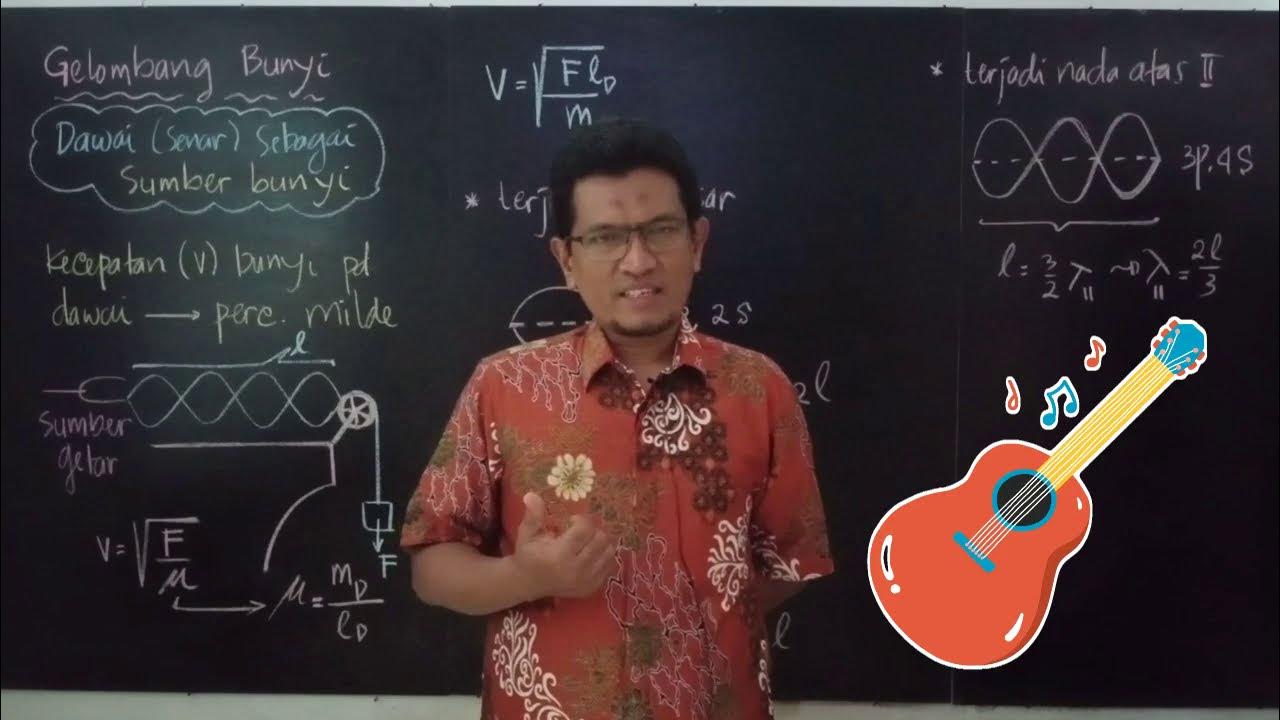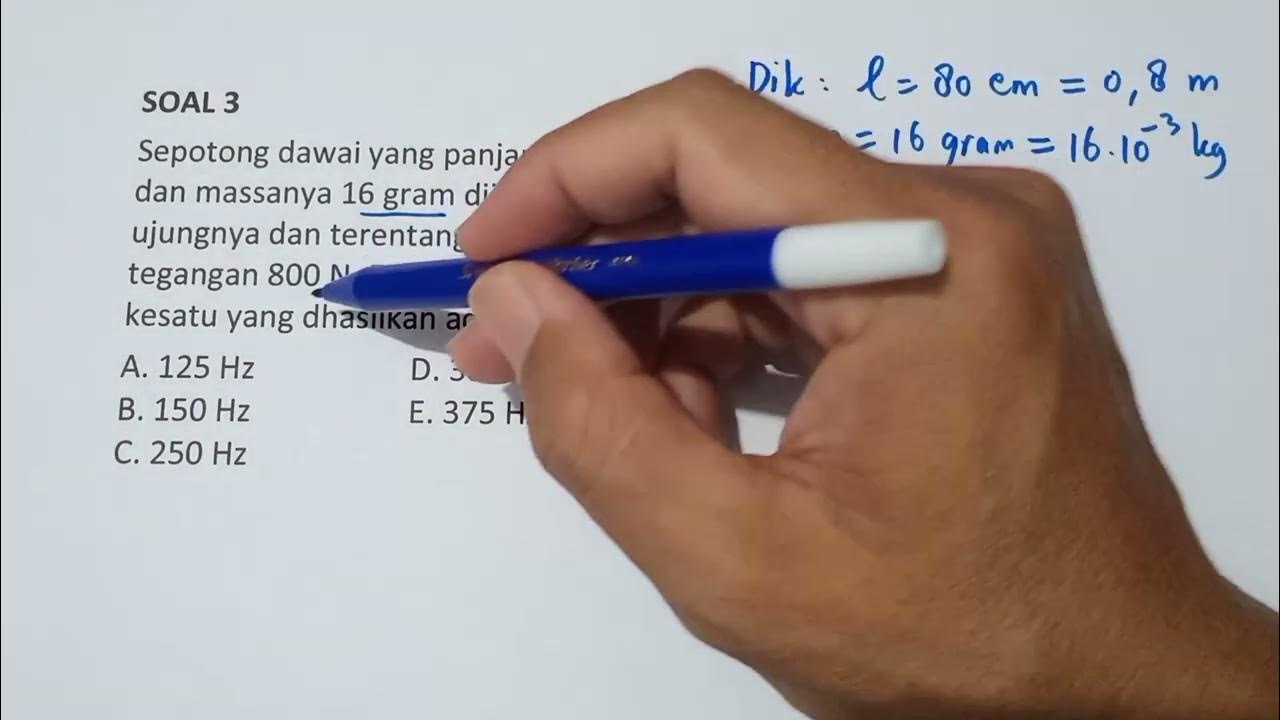Gelombang Bunyi • Part 2: Contoh Soal Cepat Rambat Gelombang Bunyi
Summary
TLDRIn this educational video, viewers are guided through a series of physics problems involving sound waves on strings, exploring concepts such as wave speed, frequency, and tension. The instructor explains the formulas for wave propagation, the relationship between tension and wave speed, and how to calculate frequency using string length and mass. Several example problems are solved step by step, illustrating how to apply these principles in real-life scenarios. The video is designed to help students understand the physics behind sound waves, particularly in the context of high school physics, with clear explanations and practical examples.
Takeaways
- 😀 The video explains how to calculate the speed of sound waves on a stretched wire using given mass, length, and tension data.
- 😀 The formula for the speed of sound on a stretched wire is derived from the square root of the tension divided by the mass per unit length.
- 😀 An example is given where a wire with a mass of 25 grams and a length of 50 cm, subjected to a 5 N force, has a wave speed of 10 m/s.
- 😀 The frequency of the sound wave produced by the wire can be found using the relation between wave speed, frequency, and wavelength.
- 😀 In the second example, the frequency of a wave on the wire is calculated as 40 Hz based on the wave speed and the wavelength.
- 😀 Another example involves a wire with a length of 80 cm and a mass of 20 grams, subjected to a 10 N force, with a frequency of 50 Hz. The number of waves formed is calculated to be 2.
- 😀 To calculate the number of waves, the wavelength is first found by determining the wave speed and then applying the relation between wave speed, frequency, and wavelength.
- 😀 The relationship between wave speed and force applied to a wire is explored with two wires of different diameters. The ratio of wave speeds is given as 2:1, and the ratio of tension forces between the two wires is calculated to be 16:1.
- 😀 The video demonstrates how the square of the tension and the cross-sectional area of the wire affects the speed of sound in the wire.
- 😀 The modulus of bulk elasticity for water is calculated, and it is shown how the speed of sound in a fluid relates to this modulus using the formula V = √(B/ρ), where B is the bulk modulus and ρ is the density of the fluid.
Q & A
What is the main topic of the video?
-The main topic of the video is the discussion of sound wave propagation, particularly focusing on examples of sound wave problems involving strings, frequencies, and wave speeds in physics.
How do you calculate the wave speed in the example of a string under tension?
-The wave speed (v) in the string is calculated using the formula v = √(F/μ), where F is the tension in the string, and μ is the linear mass density. In the example, with the given values, the wave speed is found to be 10 m/s.
What is the formula used to calculate the frequency of the sound wave?
-The formula used to calculate the frequency (f) is v = λ * f, where v is the wave speed, and λ is the wavelength. By rearranging the formula, the frequency can be found as f = v / λ.
How do you calculate the frequency of the sound wave generated by the string?
-The frequency is calculated by using the wave speed from part A (v = 10 m/s) and the wavelength λ (0.25 m). The frequency is then f = v / λ = 10 / 0.25 = 40 Hz.
How is the number of full waves on the string determined in the second example?
-The number of full waves is determined by using the length of the string (L) and the wavelength (λ). The total length of the string (0.8 m) is divided by the wavelength (0.4 m), resulting in 2 full waves.
What is the relationship between the diameter of the string and the wave speed in the given example?
-In the example, the wave speed for two strings with different diameters is compared. The diameter affects the cross-sectional area of the string, which influences the wave speed, with a larger diameter leading to a greater wave speed.
What is the formula to find the modulus of bulk elasticity for a medium like water?
-The modulus of bulk elasticity (B) for a medium can be found using the formula v = √(B/ρ), where v is the speed of sound in the medium, B is the bulk modulus, and ρ is the density of the medium.
How is the bulk modulus of water calculated from the given data?
-Using the formula v = √(B/ρ) and the given speed of sound in water (1500 m/s) and the density of water (1000 kg/m³), the bulk modulus of water is calculated as B = 2.25 × 10⁹ N/m².
What is the significance of the tension in the string for wave propagation?
-The tension in the string directly affects the speed of the wave propagating through it. A higher tension increases the wave speed, which is critical in determining the frequency and wavelength of the sound waves produced.
What does the result '16:1' represent in the comparison of the two strings?
-The result '16:1' indicates that the tension in the first string is 16 times greater than the tension in the second string, based on the comparison of their wave speeds and diameters.
Outlines

This section is available to paid users only. Please upgrade to access this part.
Upgrade NowMindmap

This section is available to paid users only. Please upgrade to access this part.
Upgrade NowKeywords

This section is available to paid users only. Please upgrade to access this part.
Upgrade NowHighlights

This section is available to paid users only. Please upgrade to access this part.
Upgrade NowTranscripts

This section is available to paid users only. Please upgrade to access this part.
Upgrade NowBrowse More Related Video

DAWAI (SENAR) SEBAGAI SUMBER BUNYI | Gelombang Bunyi #1 - Fisika Kelas 11

Mudah Mengerjakan Soal Gelombang Dawai || Fisika Kelas XI || #oprekmafiki #fisikasma #fisikaasyik

Gelombang Mekanik Fisika Kelas 11- Part 1 : Konsep Gelombang Mekanik

Percobaan Eksperimen Melde | Praktikum Fisika Dasar 1 | UPT Laboratorium Terpadu UHO

Karateristik Gelombang Transversal dan Longitudinal-Fisika 11 SMA

Gelombang Bunyi Pada Dawai (Senar) | Materi Fisika Gelombang Bunyi Kelas 11 SMA
5.0 / 5 (0 votes)